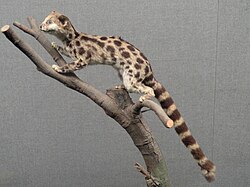Asiatic linsang
| Asiatic linsang[1] | |
|---|---|

| |
| Prionodon pardicolor | |
| Scientific classification | |
| Kingdom: | Animalia |
| Phylum: | Chordata |
| Class: | Mammalia |
| Order: | Carnivora |
| Family: | Prionodontidae Thomas Horsfield, 1822[2] |
| Subfamily: | Prionodontinae Gray, 1864[3] |
| Genus: | ''Prionodon'' Horsfield, 1822 |
| Species | |
The Asiatic linsang (Prionodon) is a genus comprising two species native to Southeast Asia: the banded linsang (Prionodon linsang) and the spotted linsang (Prionodon pardicolor).[4] Prionodon is considered basal to the Feliformia and a sister taxon of the Felidae.[5]
Taxonomic history
[edit]Prionodon was denominated and first described by Thomas Horsfield in 1822, based on a linsang from Java. He placed the genus under Prionodontidae, because of similarities to both genera Viverra and Felis.[2] In 1864, John Edward Gray nominated the subfamily Prionodontinae, to which he subordinated the genera Prionodon and Poiana.[3] Reginald Innes Pocock initially followed Gray’s classification, but the existence of scent glands in Poiana induced him provisionally to regard the latter as a specialized form of Genetta, its likeness to Prionodon being possibly adaptive.[4]
DNA analysis based on 29 species of Carnivora, comprising 13 species of Viverrinae and three species representing Paradoxurus, Paguma and Hemigalinae, confirmed Pocock's assumption that the African linsang Poiana represents the sister-group of the genus Genetta. The placement of Prionodon as the sister-group of the family Felidae is strongly supported, and it was proposed that the Asiatic linsangs be placed in the monogeneric family Prionodontidae.[6]
Characteristics
[edit]The coat pattern of the Asiatic linsang is distinct, consisting of large spots that sometimes coalesce into broad bands on the sides of the body; the tail is banded transversely. It is small in size with a head and body length ranging from 14.4 to 16.75 in (36.6 to 42.5 cm) and a 12 to 16 in (30 to 41 cm) long tail. The tail is nearly as long as the head and body, and about five or six times as long as the hind foot. The head is elongated with a narrow muzzle, rhinarium evenly convex above, with wide internarial septum, shallow infranarial portion, and philtrum narrow and grooved, the groove extending only about to the level of the lower edge of the nostrils. The delicate skull is long, low, and narrow with a well defined occipital and a strong crest, but there is no complete sagittal crest. The teeth also are more highly specialized, and show an approach to those of Felidae, although more primitive. The dental formula is Template:DentalFormula. The incisors form a transverse, not a curved, line; the first three upper and the four lower pre-molars are compressed and trenchant with a high, sharp, median cusp and small subsidiary cusps in front and behind it. The upper carnassial has a small inner lobe set far forwards, a small cusp in front of the main compressed, high, pointed cusp, and a compressed, blade-like posterior cusp; the upper molar is triangular, transversely set, much smaller than the upper carnassial, and much wider than it is long, so that the upper carnassial is nearly at the posterior end of the upper cheek-teeth as in Felidae.[4]
References
[edit]- ^ Template:MSW3 Wozencraft
- ^ Jump up to: a b Horsfield, T. (1822). Illustration of Felis gracilis in Zoological researches in Java, and the neighboring islands. Kingsbury, Parbury and Allen, London.
- ^ Jump up to: a b Gray, J. E. (1864). A revision of the genera and species of viverrine animals (Viverridae), founded on the collection in the British Museum. Proceedings of the Zoological Society of London for the year 1864: 502–579.
- ^ Jump up to: a b c Pocock, R. I. (1939). 'The fauna of British India, including Ceylon and Burma. Mammalia. – Volume 1. Taylor and Francis, London. Pages 334–342.
- ^ Barycka, E. (2007). Evolution and systematics of the feliform Carnivora. Mammalian Biology 72: 257–282.
- ^ Gaubert, P. and Veron, G. (2003). "Exhaustive sample set among Viverridae reveals the sister-group of felids: the linsangs as a case of extreme morphological convergence within Feliformia". Proceedings of the Royal Society, Series B, 270 (1532): 2523–2530. doi:10.1098/rspb.2003.2521
